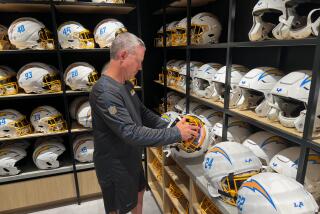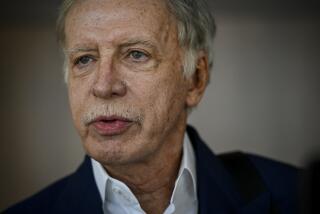Hey, Isn’t That Coach Koshalek? : MOCA’s Director Visits the 49ers to Recharge His Creative Batteries
- Share via
SAN FRANCISCO — If you want to know what really happened behind the scenes with the San Francisco 49ers late in the regular season, ask Richard Koshalek.
He should know. After all, he’s director of Los Angeles’ Museum of Contemporary Art.
It is safe to say that the idea of consulting the mild-mannered and bespectacled arts executive on 49ers strategy never occurred to the sportswriters typing away in the press box as the team was busily losing its Jan. 3 game against the Philadelphia Eagles on a chilly Monday night at Candlestick Park. That perpetually cranky crowd, canceling out their diet Cokes with bags of greasy potato chips and fretting over deadlines, never knew there was a most unlikely football expert sitting right behind them.
49ers coach George Seifert had just pulled star quarterback Steve Young off the field and replaced him with Steve Bono, just as he had during the Christmas Day game against the Houston Oilers. Then, the Steve-switch had led to widespread press speculation that there was bad blood between coach and player. But “it was all decided at the beginning of the (Oilers) game, that (Seifert) was going to take out Young,” Koshalek offered cheerfully, intently watching the action on a press box video monitor, bundled up in a bright red 49ers jacket and cap.
“(Seifert) did it for two reasons: One, he didn’t want Young to be injured before the playoffs, and second, he wanted Bono to get some playing time before the end of the game,” Koshalek continued. “So it was all decided. It had nothing to do with the score, it had nothing to do with being ahead or behind or anything. It was truly decided before the game that Young was coming out before the third quarter.”
In an odd marriage of the non-profit arts world and gazillion-dollar professional sports--made possible by a foundation grant designed to recharge his creative batteries--Koshalek has become an unlikely team insider. Instead of spending December and early January at MOCA, attending genteel exhibition openings and cajoling major donations for the museum from board members and trustees, Koshalek was following the 49ers.
On a month-long sabbatical from the museum (he returned to work Monday), Koshalek received red-carpet treatment from the team. “I’ve done everything I could possibly do--I mean, except for suiting up and going through a practice,” he said. “I’ve seen the workout sessions, I’ve met with the coach, I rode the plane coming back from Detroit (for the Dec. 19 game against the Lions at the Silverdome), I’ve gone through the quarterbacking strategy, sat in on the post-game interviews . . . the whole thing has been quite extraordinary.
“On the plane coming back from Detroit, I sat next to George Seifert, and he opened up the playbook , and (started) going through the plays. . . . The player’s playbook, that’s his life. It’s absolutely fabulous.”
Koshalek has become a font of personal tidbits about the team. Seifert, whom Koshalek describes as extremely superstitious, is a big fan of rocker Billy Idol and salmon fishing. One star player--Koshalek asked that his name not be revealed--always brings dirt from the field at Candlestick Park to away games and rubs it into the football for luck. All players take private hotel rooms on the road except Steve Young and tight end Brent Jones, who room together. “Each player goes through his own little ritual before the game,” Koshalek said.
Koshalek’s football experience is part of a 3-year-old program called the Avocational Adventure Grants. Sponsored by Los Angeles’ Durfee Foundation and offered by invitation only, the grants allow senior members of non-profit Southern California institutions to pursue an “avocational interest.” It is hoped that providing sabbaticals to executives at institutions with no such programs will encourage them to stay in their current posts rather than changing jobs to get some needed time off.
“It’s like running away to join the circus,” Koshalek, 52, said happily.
And while Koshalek is running away, who is running MOCA? “I have no idea. I have no idea what they are doing. I should call.” He laughed. “But it’s going very well. It’s holiday time, so it’s our quiet time.”
Koshalek said that grantees are not required to submit a report on their adventure or prove its relevance to their work, but noted he had discovered some similarities between his job and that of the 49ers head coach. “(Seifert) says, ‘Richard, how do you find artists whose work is of value?’ I said: ‘We have lists of people, we do our research, we talk to a lot of people, and we sort of come up with a final list.’ And he said: ‘That’s the same way we draft football players.’ ”
An Avocational Adventure grantee is the architect of his or her own adventure. For Koshalek, a Wisconsin native who grew up playing high school football and attending college games in Madison with his father, his dream was to follow a professional team. He acknowledges that the 49ers were more than a little surprised that an arts executive knew so much about the game. Finding the Durfee Foundation receptive to the idea, Koshalek called a friend, downtown attorney Frank Rothman, who represents the National Football League, and asked for help in finding the right team.
“I knew Richard’s personality and I knew the personality of 49ers president Carmen Policy,” Rothman said. “I just knew those two would meld. (Policy) is a very sophisticated, culturally intelligent man. I knew he would understand when he got a call from the director of a contemporary art museum. Others sports people are not so interested in contemporary art.”
Rothman did not want to pair Koshalek to the Los Angeles Raiders because “I thought it might be nice if . . . he got to be with a Super Bowl team. I thought, it’s possible that that may happen for the 49ers. It wouldn’t probably happen for the Los Angeles team.”
Former 49er wide receiver R. C. Owens, who joined the ranks of team management 14 years ago as executive assistant and alumni coordinator, says the team has never allowed a glimpse behind the scenes to “see it all, if you will. (Koshalek) has had a chance to be in the dressing room, hear the coach’s pre-game speech . . . and see how the players are writhing with intensity to go out on the field to play and hopefully get the job done.”
Policy agreed: “In some ways, what (Koshalek) did is unique. You have to have the right individual who does not represent a distraction, who is not threatening, in a sense, to really let the barriers down. We were permitting him to come into the inner sanctum.”
Policy acknowledged he was shocked to see Seifert open up the playbook for Koshalek. And he praised the museum director for avoiding a common tendency to stereotype athletes and coaches as dumb. “Here is Richard, carrying on this football conversation with George Seifert, and they’ll lapse into a conversation about art,” he said. “It was quite intriguing.”
Policy said he has paid a visit to MOCA. “I was there for the John Cage exhibit, and I was really impressed with the way the gallery ran--even though I was not impressed with some of their, er, terribly valuable pieces,” he said.
While Koshalek said he was indeed impressed by the intelligence of team members, he was also struck (no pun intended) by the impact of bodies against bodies. “It’s a high decibel event,” he said. “On the field, it’s totally different from up here (in the press box), totally different from watching it on television. You magnify it 100 times--the impact, the hits, the total effort that goes into it.” Koshalek pulled a small, pale-green packet of smelling salts from his pocket. “On the bench, there’s a lot of this going on,” he said, waving it under his nose.
Koshalek was fascinated to watch the linebackers soberly taping their pads to their bodies with double-face tape before the game to make sure their shirts will fit skin-tight. “The concentration and concern that’s on their faces--sometimes I said: ‘That looks like fear,’ ” Koshalek said. “And one of the guys said: ‘Damn right it’s fear!’
While offering a standing invitation for the 49ers to come to MOCA, Koshalek said he has no plans to tap into football money in the museum’s perpetual search for board members and donors. “This was just for me,” he said.
More to Read
Go beyond the scoreboard
Get the latest on L.A.'s teams in the daily Sports Report newsletter.
You may occasionally receive promotional content from the Los Angeles Times.










